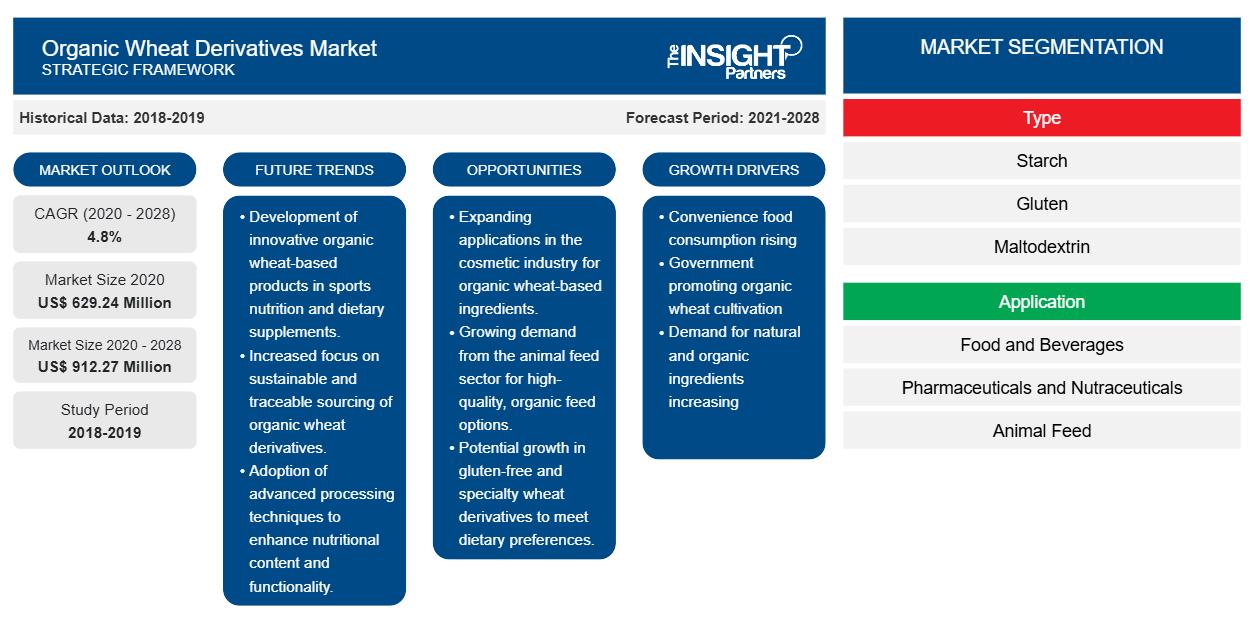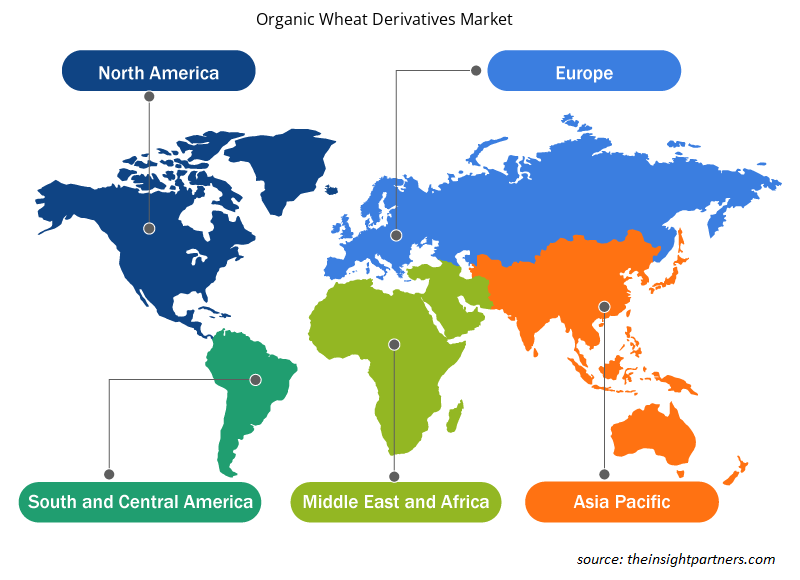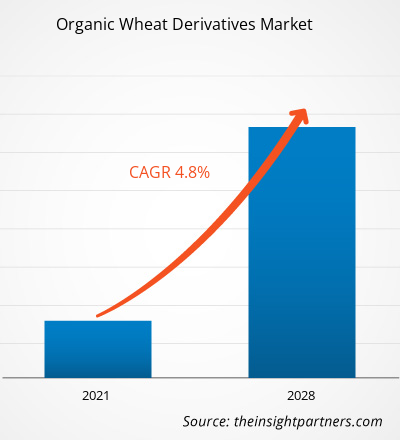The organic wheat derivatives market was valued at US$ 629,235.10 thousand in 2020 and is projected to reach US$ 912,272.31 thousand by 2028; it is expected to grow at a CAGR of 4.8% from 2021 to 2028.
Organic wheat derivatives and the by-products, such as starch, gluten, bran, DDGS, and maltodextrin, obtained from organic wheat processing. The shift in consumers lifestyle and dietary patterns has surged the demand for healthy food products and their ingredients. With the growing emphasis on health along with rising focus on the consumption of natural food ingredients, the demand for organic wheat derivatives have gone up steadily. Organic form of wheat derivatives is perceived to be a nutritious alternative, and it supports several application bases owing to their properties. For instance, the organic form of wheat starch has gained importance in the food & beverage industry. It is treated as an essential ingredient in the preparation of various food products such as cakes, biscuits, breads, waffles other baked items due to its superior gelling, stabilizing, and thickening properties.
In 2020, North America accounted for the largest share in the organic wheat derivatives market. The well-established food sector in North American countries provides a wide consumer base for organic wheat derivatives manufacturers operating in the region. Growing demand for organic wheat derivatives in the preparation of several bakery and fast-food products is offering a growth opportunity for the organic wheat derivatives producers. The demand for organic wheat derivatives in North America has surged owing to the increasing consumption of convenience food items such as bakery products, snacks, noodles, and pasta due to a busy lifestyle and hectic work schedule of the consumers.
The COVID-19 outbreak pandemic has adversely affected economies and industries in various countries due to lockdowns, travel restrictions, and business shutdowns. The pandemic has drastically altered the status of the organic wheat derivatives industry and has negatively impacted the growth of the market. The COVID-19 outbreak has distorted operational efficiency and disrupted the value chains due to the sudden closure of national and international boundaries, creating revenue loss and damage. The disruptive value chain restricted the raw material supply, which, in turn, is negatively impacting the growth of the organic wheat derivatives market. However, as the economies are planning to revive their operations, the demand for organic wheat derivatives is expected to rise globally in coming years. Although the focus over just-in-time production is another concerning factor hindering market growth. With the growing consciousness toward health amongst consumers and diversification of application bases in post-pandemic times, the demand for organic wheat derivatives is expected to take huge leap. For instance, as per a report published by Organic Trade Association, the unprecedented situations caused by COVID-19 pandemic have, in turn, forced the consumers to consume healthy, clean, and natural alternatives. This change has propelled the demand for organic food products. Further, positive measures undertaken by government to promote organic wheat cultivation are expected to bolster the market growth during the forecast period.
Customize This Report To Suit Your Requirement
You will get customization on any report - free of charge - including parts of this report, or country-level analysis, Excel Data pack, as well as avail great offers and discounts for start-ups & universities
Organic Wheat Derivatives Market: Strategic Insights

- Get Top Key Market Trends of this report.This FREE sample will include data analysis, ranging from market trends to estimates and forecasts.
You will get customization on any report - free of charge - including parts of this report, or country-level analysis, Excel Data pack, as well as avail great offers and discounts for start-ups & universities
Organic Wheat Derivatives Market: Strategic Insights

- Get Top Key Market Trends of this report.This FREE sample will include data analysis, ranging from market trends to estimates and forecasts.
Market Insights
Rise in Demand for Natural and Organic Ingredients
The importance of organic food items has been understood in the wake of alarming health issues, coupled with rising consciousness about organic certifications and growing preference for high quality food items. Nowadays, consumers are looking for natural, clean, and simple ingredients with proper labels, which could effectively convey their contents, quality, and intent of the product use. Currently, the consumers are quite concerned about using conventional food products due to their contribution to increasing incidence of health issues. This has encouraged the manufacturers to develop products based on consumer’s expectations. Further, as per an estimate, almost 45% of families in the US are largely dependent upon organic and natural food products. Manufacturers of wheat derivatives are also focusing on developing and marketing organic wheat derivatives owing to the market’s demand.
Type Insights
Based on type, the organic wheat derivatives market is segmented into starch, gluten, maltodextrin, and others. The starch segment led the market with the largest share in 2020. Organic wheat starch is a polysaccharide established from amylose and amylopectin. The starch consists of a carbohydrate fraction of wheat flour of premium quality. Its unique characteristics make the product highly useful in several industrial segments, such as food & beverages, pharmaceuticals, personal care, and animal feed. Food starches are majorly added to various food and beverage items, such as sauces, soups, puddings, salad dressings, pie fillings, and several baking applications, to stabilize or thicken them. When used in food, organic wheat starch assists with gel formation, viscosity, adhesion, texture, moisture retention, and binding. The starch can be used as a fat substitute. It further works as a stabilizer, clouding, emulsifier, or glazing agent.
A few key market players operating in the organic wheat derivatives market are SACCHETTO SPA; Cargill, Incorporated; ETEA S.R.L.,; Archer Daniels Midland Company; AGRANA Beteiligungs-AG; Kröner-Starke Bio; Amylon; Manildra Group; Ulrick & Short Limited; and Tate & Lyle PLC. Major market players are adopting strategies such as mergers and acquisitions and product launches to expand their geographical presence and consumer base globally.
Report Spotlights
- Progressive industry trends in the global organic wheat derivatives market to help players develop effective long-term strategies.
- Business growth strategies adopted by developed and developing markets.
- Quantitative analysis of the global organic wheat derivatives market from 2019 to 2028
- Estimation of the demand for organic wheat derivatives across various industries
- PEST analysis to illustrate the efficacy of buyers and suppliers operating in the industry to predict market growth.
- Recent developments to understand the competitive market scenario and the demand for organic wheat derivatives.
- Market trends and outlook coupled with factors driving and restraining the growth of the organic wheat derivatives market.
- Decision-making process by understanding strategies that underpin commercial interest with regard to global organic wheat derivatives market growth.
- Organic wheat derivatives market size at various nodes of market
- Detailed overview and segmentation of the global organic wheat derivatives market as well as its dynamics in the industry.
- Organic wheat derivatives market size in various regions with promising growth opportunities
Organic Wheat Derivatives Market Regional Insights
The regional trends and factors influencing the Organic Wheat Derivatives Market throughout the forecast period have been thoroughly explained by the analysts at Insight Partners. This section also discusses Organic Wheat Derivatives Market segments and geography across North America, Europe, Asia Pacific, Middle East and Africa, and South and Central America.

- Get the Regional Specific Data for Organic Wheat Derivatives Market
Organic Wheat Derivatives Market Report Scope
| Report Attribute | Details |
|---|---|
| Market size in 2020 | US$ 629.24 Million |
| Market Size by 2028 | US$ 912.27 Million |
| Global CAGR (2020 - 2028) | 4.8% |
| Historical Data | 2018-2019 |
| Forecast period | 2021-2028 |
| Segments Covered |
By Type
|
| Regions and Countries Covered | North America
|
| Market leaders and key company profiles |
Organic Wheat Derivatives Market Players Density: Understanding Its Impact on Business Dynamics
The Organic Wheat Derivatives Market is growing rapidly, driven by increasing end-user demand due to factors such as evolving consumer preferences, technological advancements, and greater awareness of the product's benefits. As demand rises, businesses are expanding their offerings, innovating to meet consumer needs, and capitalizing on emerging trends, which further fuels market growth.
Market players density refers to the distribution of firms or companies operating within a particular market or industry. It indicates how many competitors (market players) are present in a given market space relative to its size or total market value.
Major Companies operating in the Organic Wheat Derivatives Market are:
- AGRANA Beteiligungs-AG
- Amylon
- Archer Daniels Midland Company
- Cargill, Incorporated
- ETEA S.R.L.
Disclaimer: The companies listed above are not ranked in any particular order.

- Get the Organic Wheat Derivatives Market top key players overview
Organic Wheat Derivatives Market, by Type
- Starch
- Gluten
- Maltodextrin
- Others
Organic Wheat Derivatives Market, by Application
- Food and Beverages
- Pharmaceuticals & Nutraceuticals
- Animal Feed
- Personal Care
- Others
Company Profiles
- SACCHETTO SPA
- Cargill, Incorporated
- ETEA S.R.L.
- Archer Daniels Midland Company
- AGRANA Beteiligungs-AG
- Kröner-Starke Bio
- Amylon
- Manildra Group
- Ulrick & Short Limited
- Tate & Lyle PLC
Frequently Asked Questions
Based on type, why is the starch segment dominating the market during 2020–2028?
The starch segment held the largest share in the global organic wheat derivatives market in 2020. It is majorly added to stabilize or thicken products such as sauces, soups, puddings, salad dressings, pie fillings, and several baking applications. When used in food, organic wheat starch assists with gel formation, viscosity, adhesion, texture, moisture retention, binding and can be used as a fat substitute.
Can you list some of the major players operating in the global organic wheat derivatives market?
The major players operating in the global organic wheat derivatives market are SACCHETTO SPA; Cargill, Incorporated; ETEA S.R.L.; Archer Daniels Midland Company; AGRANA Beteiligungs-AG; Kröner-Starke Bio; Amylon; Manildra Group; Ulrick & Short Limited; and Tate & Lyle PLC among many others.
Which region held the largest share of the global organic wheat derivatives market?
In 2020, North America accounted for the largest share in the global organic wheat derivatives market. The well-established food sector in North American countries provides a wide consumer base for organic wheat derivatives manufacturers operating in the region. Growing demand for organic wheat derivatives for the preparation of several bakery and fast-food products is providing a growth opportunity for the organic wheat derivatives producers. The demand for organic wheat derivatives in North America has surged owing to the increasing consumption of convenience food such as bakery products, snacks, noodles, and pasta due to a busy lifestyle and hectic work schedule of the consumers.
- Historical Analysis (2 Years), Base Year, Forecast (7 Years) with CAGR
- PEST and SWOT Analysis
- Market Size Value / Volume - Global, Regional, Country
- Industry and Competitive Landscape
- Excel Dataset
Testimonials
I wish to appreciate your support and the professionalism you displayed in the course of attending to my request for information regarding to infectious disease IVD market in Nigeria. I appreciate your patience, your guidance, and the fact that you were willing to offer a discount, which eventually made it possible for us to close a deal. I look forward to engaging The Insight Partners in the future, all thanks to the impression you have created in me as a result of this first encounter.
DR CHIJIOKE ONYIA, MANAGING DIRECTOR, PineCrest Healthcare Ltd.The Insight Partners delivered insightful, well-structured market research with strong domain expertise. Their team was professional and responsive throughout. The user-friendly website made accessing industry reports seamless. We highly recommend them for reliable, high-quality research services
Yukihiko Adachi CEO, Deep Blue, LLC.Reason to Buy
- Informed Decision-Making
- Understanding Market Dynamics
- Competitive Analysis
- Customer Insights
- Market Forecasts
- Risk Mitigation
- Strategic Planning
- Investment Justification
- Identifying Emerging Markets
- Enhancing Marketing Strategies
- Boosting Operational Efficiency
- Tracking Industry Innovations
- Aligning with Regulatory Trends
Yes! We provide a free sample of the report, which includes Report Scope (Table of Contents), report structure, and selected insights to help you assess the value of the full report. Please click on the "Download Sample" button or contact us to receive your copy.
Absolutely — analyst assistance is part of the package. You can connect with our analyst post-purchase to clarify report insights, methodology or discuss how the findings apply to your business needs.
Once your order is successfully placed, you will receive a confirmation email along with your invoice.
• For published reports: You’ll receive access to the report within 4–6 working hours via a secured email sent to your email.
• For upcoming reports: Your order will be recorded as a pre-booking. Our team will share the estimated release date and keep you informed of any updates. As soon as the report is published, it will be delivered to your registered email.
We offer customization options to align the report with your specific objectives. Whether you need deeper insights into a particular region, industry segment, competitor analysis, or data cut, our research team can tailor the report accordingly. Please share your requirements with us, and we’ll be happy to provide a customized proposal or scope.
The report is available in either PDF format or as an Excel dataset, depending on the license you choose.
The PDF version provides the full analysis and visuals in a ready-to-read format. The Excel dataset includes all underlying data tables for easy manipulation and further analysis.
Please review the license options at checkout or contact us to confirm which formats are included with your purchase.
Our payment process is fully secure and PCI-DSS compliant.
We use trusted and encrypted payment gateways to ensure that all transactions are protected with industry-standard SSL encryption. Your payment details are never stored on our servers and are handled securely by certified third-party processors.
You can make your purchase with confidence, knowing your personal and financial information is safe with us.
Yes, we do offer special pricing for bulk purchases.
If you're interested in purchasing multiple reports, we’re happy to provide a customized bundle offer or volume-based discount tailored to your needs. Please contact our sales team with the list of reports you’re considering, and we’ll share a personalized quote.
Yes, absolutely.
Our team is available to help you make an informed decision. Whether you have questions about the report’s scope, methodology, customization options, or which license suits you best, we’re here to assist. Please reach out to us at sales@theinsightpartners.com, and one of our representatives will get in touch promptly.
Yes, a billing invoice will be automatically generated and sent to your registered email upon successful completion of your purchase.
If you need the invoice in a specific format or require additional details (such as company name, GST, or VAT information), feel free to contact us, and we’ll be happy to assist.
Yes, certainly.
If you encounter any difficulties accessing or receiving your report, our support team is ready to assist you. Simply reach out to us via email or live chat with your order information, and we’ll ensure the issue is resolved quickly so you can access your report without interruption.















The List of Companies - Organic Wheat Derivatives Market
- AGRANA Beteiligungs-AG
- Amylon
- Archer Daniels Midland Company
- Cargill, Incorporated
- ETEA S.R.L.
- Kröner-Starke Bio
- Manildra Group
- SACCHETTO SPA
- Tate & Lyle PLC
- Ulrick & Short Limited






 Get Free Sample For
Get Free Sample For